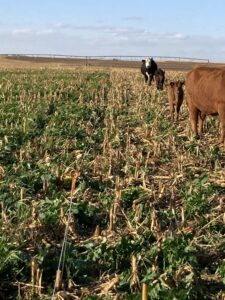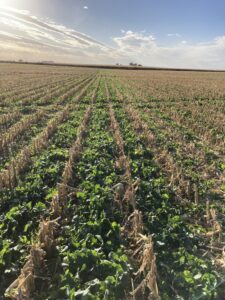In 2019, I was sitting in my Beef Industry Issues class at University of Nebraska Lincoln and we were tasked with identifying issues facing the industry. A primary issue our class listed was consumers’ perception of the carbon footprint of cattle. Everyone in the room knew the claims lacked substance. Ruminants were on the land before we were! While it is easy to point the finger at someone else and rail against their ignorance, perhaps we should also reflect on how we can improve our current beef management practices. What changes can we implement to shift the consumer narrative and opinion and solidify the fact that animal agriculture can be a regenerative solution when it comes to capturing carbon?
 I got my start in the cattle business by purchasing a few heifers and bred cows from my grandfather in the summer of 2018. I run the cattle with my father, who has graciously allowed me to make the bulk of the management decisions for our operation in south central Nebraska. In my area, the high value, mostly irrigated ground is primarily used for corn and soybeans, making pasture ground hard to find. As a young producer with limited resources, I decided that if I wanted to grow our operation, I was going to get creative with how I managed our herd. Our cows calve in August, and we wean calves in April, which gives us a tremendous opportunity to be flexible using perennial pastures and row crop residues to graze and capture carbon.
I got my start in the cattle business by purchasing a few heifers and bred cows from my grandfather in the summer of 2018. I run the cattle with my father, who has graciously allowed me to make the bulk of the management decisions for our operation in south central Nebraska. In my area, the high value, mostly irrigated ground is primarily used for corn and soybeans, making pasture ground hard to find. As a young producer with limited resources, I decided that if I wanted to grow our operation, I was going to get creative with how I managed our herd. Our cows calve in August, and we wean calves in April, which gives us a tremendous opportunity to be flexible using perennial pastures and row crop residues to graze and capture carbon.
In the summer of 2020, I started to subdivide my limited pasture ground into smaller paddocks and began intensive grazing management techniques. Prior to this change, my pasture was dominated by cool season grasses, but now I can keep my grass in a constant vegetative state and allow warm season grasses and legumes to grow, adding more diversity to the pasture. This system captures the maximum amount of carbon into the soil. Additionally, I decided to use cover crops as forage for my cattle. Since the majority of land that I had access to was corn or beans, I aerial seeded covers into standing corn.
This year, I flew on two mixes into hailed corn to take advantage of the extra sunlight hitting the ground in the damaged fields. I did an “early fall” mix of foxtail millet, spring triticale, and radishes and a “winter” mix of rye, turnips, and rapeseed. This has allowed me to meet cow nutritional requirements through peak lactation and breeding season with the “early mix” while providing extra feed during the harsher winter months with the rye and turnips. I use polywire and step-in posts to limit grazing selectivity. I have been pleased with how this approach has worked thus far and I’m intrigued to see how it progresses.
 Looking towards the future for our operation, I hope to continue to regenerate the land and be a holistic land manager. Some of the practices I look at implementing include cover cropping after wheat, seeding warm season annuals into cool season pastures, and using more legumes in perennial pastures to boost productivity. I would like to continue growing the operation by integrating additional livestock species. I think there could be a tremendous upside to multi-species grazing for the land and the animals.
Looking towards the future for our operation, I hope to continue to regenerate the land and be a holistic land manager. Some of the practices I look at implementing include cover cropping after wheat, seeding warm season annuals into cool season pastures, and using more legumes in perennial pastures to boost productivity. I would like to continue growing the operation by integrating additional livestock species. I think there could be a tremendous upside to multi-species grazing for the land and the animals.
I have had a passion for agriculture from the time I was a young riding on my grandpa’s lap, and I want to see this industry flourish for generations to come. With a rapidly growing population and land becoming more scarce for food production, producers are going to have to be creative on how we integrate livestock back onto the landscape. Livestock are a keystone species to maintaining healthy soil, land, and people, and should be part of the solution when it comes to sequestering carbon.
This article first appeared in the 9th Edition of Green Cover's Soil Health Resource Guide.
Also check out the 11th edition, our latest Soil Health Resource Guide, over 90 pages packed with scientific articles and fascinating stories from soil health experts, researchers, farmers, innovators, and more! All as our complimentary gift to you, a fellow soil health enthusiast!
